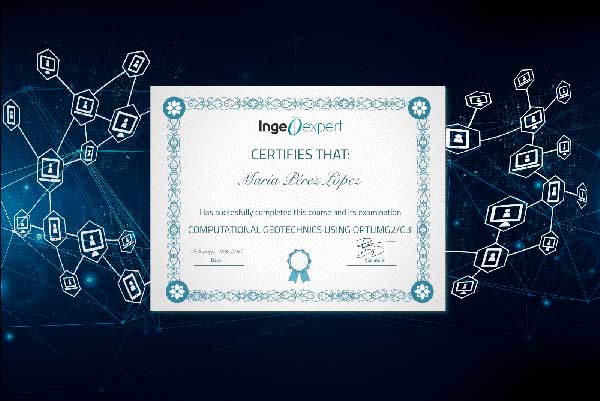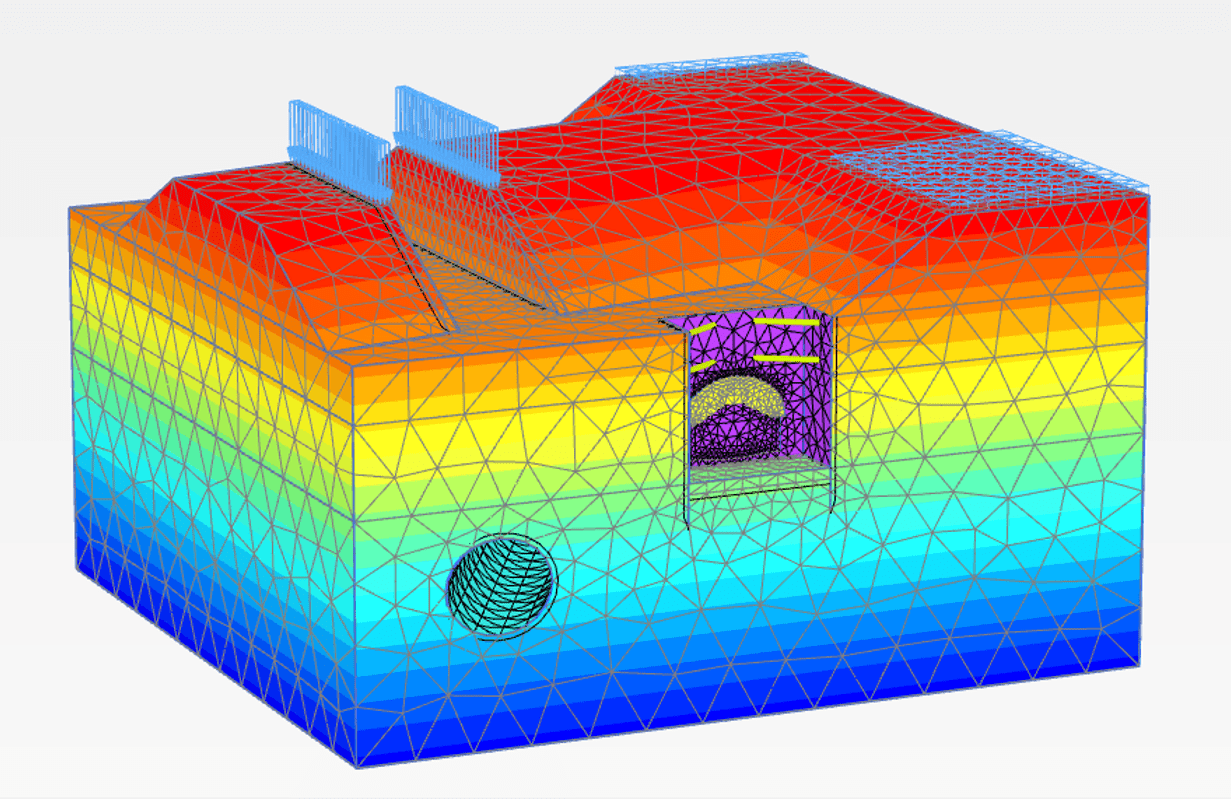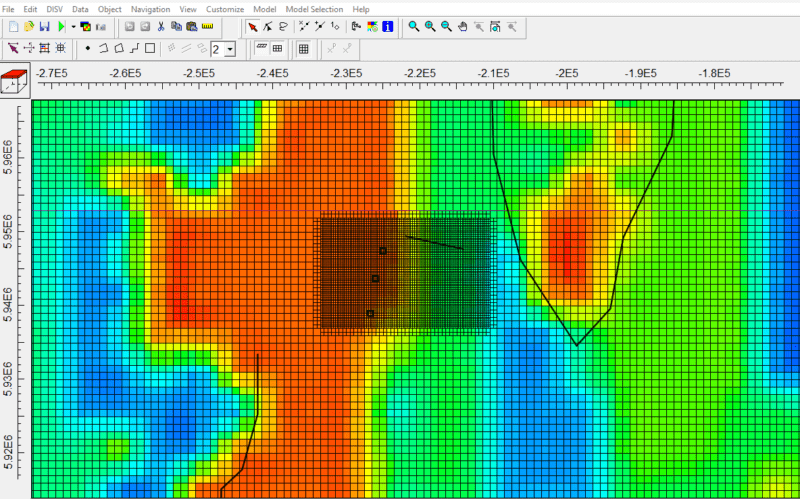Introduction to Quantitative Hydrogeology and Groundwater Modeling with MODFLOW
Online course |
|
50 hours / 6 weeks |
|
|
Dates: 17th of February to 31st of March |
| Standard | Unemployed Or Student |
| $313 | $227 |
Introduction
Quantitative hydrogeology entails the development and application of quantitative tools and approaches for understanding the flow of water through soil and aquifer systems in the near-surface environment. This includes a vast array of subtopics, ranging from estimating rates of groundwater flow from potentiometric surface measurements and hydraulic conductivity distributions, interpretation of pumping tests, understanding the unsaturated flow of water through the vadose zone in response to different boundary conditions, and predicting the flow patterns of groundwater in heterogeneous aquifers using mathematical tools ranging from simple analytical models to sophisticated numerical simulators. In a future likely to be characterized by water scarcity and climate change impacts, an understanding of how to characterize and model these types of problems – and many more – will be essential for protecting and optimizing the use of groundwater resources.
Objectives
This course will provide an introduction to a variety of concepts in quantitative hydrogeology, with a strong focus on applying the U.S. Geological Survey’s MODFLOW groundwater flow model and its various supporting packages to demonstration examples. These examples will vary in complexity and will encompass a range of processes occurring across different spatial scales. In addition to MODFLOW, other quantitative tools will be introduced and explored, including analytical flow models, approaches for modeling unsaturated flow through the vadose zone, and tracing groundwater flow paths across potentiometric surfaces using scripting. All simulation tools used in the course will be available in the public domain for download or else custom-developed for the course; no commercial software license purchases will be required.
At the conclusion of the course, students will:
- Understand key quantitative hydrogeologic concepts and parameterizations, including Darcy’s law and the continuity equation, hydraulic conductivity, aquifer storage, saturation-dependent unsaturated flow through the vadose zone, and techniques for modeling recharge, evapotranspiration, and dynamically linking groundwater flow with surface water bodies (streams and lakes)
- Be able to construct MODFLOW models for a variety of aquifer environments across different spatial scales. Specifically, the course will rely upon MODFLOW-6 and the U.S. Geological Survey’s ModelMuse graphical user interface.
- Understand how to use spreadsheets and scripting to analyze groundwater flow problems.
The course will be presented through the use of multimedia explanatory exercises, instructional videos, and webinars that involve working through specific example applications.
Please note that while the course will provide a brief introduction to the topic of solute transport in groundwater, this will not be a principal focus area.
- Introduction to quantitative hydrogeology: Darcy’s law and the continuity equation, parameterization (hydraulic conductivity, anisotropy, storage coefficient), basic concepts in analytical and numerical modeling, Richards equation and introduction to vadose zone modeling concepts.
- Aquifer conceptual models: aquifers and aquitards, unconsolidated alluvial and fluvial environments, consolidated rock and the influences of geological structures such as faults and folds on groundwater flow. Simple models for 2-D flow with respect to an irregular potentiometric surface.
- Introduction to MODFLOW: program and graphical user interface installation, simulator capabilities and limitations, overview of the functionality of key supporting packages.
- Working with MODFLOW: from simple demonstration problems to more complex aquifer geometries across larger spatial scales.
- Pumping test interpretation: analytical and numerical model approaches.
- Modeling surface water – groundwater interactions with MODFLOW.
- Unsaturated flow: basic modeling concepts, examples with the U.S. Geological Survey’s VS2DT model, simplified approaches for addressing flow through the vadose zone with MODFLOW.
- Putting it all together: groundwater flow modeling at the basin scale; model calibration and parameter sensitivity.
- An introduction to solute transport modeling.
- Special topics: Coding considerations for a versatile groundwater model, mesh design, python scripting to support numerical analysis.
Walt McNab
Walt McNab is a hydrogeologist with over 30 years of professional experience, including roles as a research scientist with Lawrence Livermore National Laboratory, California, USA, and as a consultant for environmental and water supply projects. His primary interests involve simulation of flow, transport, and chemical processes in groundwater and soil systems, and scientific programming to support quantitative data analysis and development of customized simulation tools using Python and Julia. His modeling expertise includes geochemical/reactive transport models (PHREEQC/PHAST), groundwater flow (MODFLOW), flow and transport through unsaturated soils (HYDRUS, VS2DT), as well as multiphase flow through porous media (custom-developed simulation tools). He holds a Ph.D. from the University of California, Berkeley, and is a registered Professional Geologist in California, USA.
The course is delivered online through our easy-to-use Virtual Campus platform. For this course, a variety of content is provided including:
– eLearning materials
– Videos
– Interactive multimedia content
– Live webinar classes
– Texts and technical articles
– Case studies
– Assignments and evaluation exercises
Students can download the materials and work through the course at their own pace. We regularly update this course to ensure the latest news and state-of-the-art developments are covered, and your knowledge of the subject is current.
Live webinars form part of our course delivery. These allow students and tutors to go through the course materials, exchange ideas and knowledge, and solve problems together in a virtual classroom setting. Students can also make use of the platform’s forum, a meeting point to interact with tutors and other students.
The tutoring system is managed by email. Students can email the tutor with any questions about the course and the tutor will be happy to help.
This course is aimed at hydrogeologists as well as environmental engineers and scientists with some familiarity with the basic principles of hydrogeology (e.g., Darcy’s law, understanding of hydraulic conductivity and hydraulic potential) and who are comfortable with calculus concepts at an introductory (preferably intermediate) level. Students should also have some proficiency working with spreadsheets and – ideally, but not required – experience and using two- or three-dimensional data visualization packages (e.g., Surfer, GIS, Paraview). Python scripting experience will also be very helpful for understanding some of the scripting exercises but is not an absolute course requirement.
Once a student finishes the course and successfully completes the assignments and evaluation tests, they are sent an accreditation certificate. The certificate is issued by Ingeoexpert to verify that the student has passed the course. It is a digital certificate that is unique and tamper-proof – it is protected by Blockchain technology. This means it is possible for anyone to check that it is an authentic, original document.
You will be able to download the certificate in an electronic format from the Virtual Campus platform. The certificate can be forwarded by email, shared on social networks, and embedded on websites. To see an example, click here.
Groundwater flow modeling and quantitative data interpretation skills are highly advantageous for practicing hydrogeologists. Familiarity with MODFLOW and its associated packages for simulating coupled groundwater-surface water processes at the basin scale, tools for modeling unsaturated flow, pumping test interpretation with numerical models, and other specialized approaches for quantitative hydrogeologic analyses will further enhance practitioner marketability.
Introduction
Quantitative hydrogeology entails the development and application of quantitative tools and approaches for understanding the flow of water through soil and aquifer systems in the near-surface environment. This includes a vast array of subtopics, ranging from estimating rates of groundwater flow from potentiometric surface measurements and hydraulic conductivity distributions, interpretation of pumping tests, understanding the unsaturated flow of water through the vadose zone in response to different boundary conditions, and predicting the flow patterns of groundwater in heterogeneous aquifers using mathematical tools ranging from simple analytical models to sophisticated numerical simulators. In a future likely to be characterized by water scarcity and climate change impacts, an understanding of how to characterize and model these types of problems – and many more – will be essential for protecting and optimizing the use of groundwater resources.
Objectives
This course will provide an introduction to a variety of concepts in quantitative hydrogeology, with a strong focus on applying the U.S. Geological Survey’s MODFLOW groundwater flow model and its various supporting packages to demonstration examples. These examples will vary in complexity and will encompass a range of processes occurring across different spatial scales. In addition to MODFLOW, other quantitative tools will be introduced and explored, including analytical flow models, approaches for modeling unsaturated flow through the vadose zone, and tracing groundwater flow paths across potentiometric surfaces using scripting. All simulation tools used in the course will be available in the public domain for download or else custom-developed for the course; no commercial software license purchases will be required.
At the conclusion of the course, students will:
- Understand key quantitative hydrogeologic concepts and parameterizations, including Darcy’s law and the continuity equation, hydraulic conductivity, aquifer storage, saturation-dependent unsaturated flow through the vadose zone, and techniques for modeling recharge, evapotranspiration, and dynamically linking groundwater flow with surface water bodies (streams and lakes)
- Be able to construct MODFLOW models for a variety of aquifer environments across different spatial scales. Specifically, the course will rely upon MODFLOW-6 and the U.S. Geological Survey’s ModelMuse graphical user interface.
- Understand how to use spreadsheets and scripting to analyze groundwater flow problems.
The course will be presented through the use of multimedia explanatory exercises, instructional videos, and webinars that involve working through specific example applications.
Please note that while the course will provide a brief introduction to the topic of solute transport in groundwater, this will not be a principal focus area.
- Introduction to quantitative hydrogeology: Darcy’s law and the continuity equation, parameterization (hydraulic conductivity, anisotropy, storage coefficient), basic concepts in analytical and numerical modeling, Richards equation and introduction to vadose zone modeling concepts.
- Aquifer conceptual models: aquifers and aquitards, unconsolidated alluvial and fluvial environments, consolidated rock and the influences of geological structures such as faults and folds on groundwater flow. Simple models for 2-D flow with respect to an irregular potentiometric surface.
- Introduction to MODFLOW: program and graphical user interface installation, simulator capabilities and limitations, overview of the functionality of key supporting packages.
- Working with MODFLOW: from simple demonstration problems to more complex aquifer geometries across larger spatial scales.
- Pumping test interpretation: analytical and numerical model approaches.
- Modeling surface water – groundwater interactions with MODFLOW.
- Unsaturated flow: basic modeling concepts, examples with the U.S. Geological Survey’s VS2DT model, simplified approaches for addressing flow through the vadose zone with MODFLOW.
- Putting it all together: groundwater flow modeling at the basin scale; model calibration and parameter sensitivity.
- An introduction to solute transport modeling.
- Special topics: Coding considerations for a versatile groundwater model, mesh design, python scripting to support numerical analysis.
Walt McNab
Walt McNab is a hydrogeologist with over 30 years of professional experience, including roles as a research scientist with Lawrence Livermore National Laboratory, California, USA, and as a consultant for environmental and water supply projects. His primary interests involve simulation of flow, transport, and chemical processes in groundwater and soil systems, and scientific programming to support quantitative data analysis and development of customized simulation tools using Python and Julia. His modeling expertise includes geochemical/reactive transport models (PHREEQC/PHAST), groundwater flow (MODFLOW), flow and transport through unsaturated soils (HYDRUS, VS2DT), as well as multiphase flow through porous media (custom-developed simulation tools). He holds a Ph.D. from the University of California, Berkeley, and is a registered Professional Geologist in California, USA.
The course is delivered online through our easy-to-use Virtual Campus platform. For this course, a variety of content is provided including:
– eLearning materials
– Videos
– Interactive multimedia content
– Live webinar classes
– Texts and technical articles
– Case studies
– Assignments and evaluation exercises
Students can download the materials and work through the course at their own pace. We regularly update this course to ensure the latest news and state-of-the-art developments are covered, and your knowledge of the subject is current.
Live webinars form part of our course delivery. These allow students and tutors to go through the course materials, exchange ideas and knowledge, and solve problems together in a virtual classroom setting. Students can also make use of the platform’s forum, a meeting point to interact with tutors and other students.
The tutoring system is managed by email. Students can email the tutor with any questions about the course and the tutor will be happy to help.
This course is aimed at hydrogeologists as well as environmental engineers and scientists with some familiarity with the basic principles of hydrogeology (e.g., Darcy’s law, understanding of hydraulic conductivity and hydraulic potential) and who are comfortable with calculus concepts at an introductory (preferably intermediate) level. Students should also have some proficiency working with spreadsheets and – ideally, but not required – experience and using two- or three-dimensional data visualization packages (e.g., Surfer, GIS, Paraview). Python scripting experience will also be very helpful for understanding some of the scripting exercises but is not an absolute course requirement.
Once a student finishes the course and successfully completes the assignments and evaluation tests, they are sent an accreditation certificate. The certificate is issued by Ingeoexpert to verify that the student has passed the course. It is a digital certificate that is unique and tamper-proof – it is protected by Blockchain technology. This means it is possible for anyone to check that it is an authentic, original document.
You will be able to download the certificate in an electronic format from the Virtual Campus platform. The certificate can be forwarded by email, shared on social networks, and embedded on websites. To see an example, click here.
Groundwater flow modeling and quantitative data interpretation skills are highly advantageous for practicing hydrogeologists. Familiarity with MODFLOW and its associated packages for simulating coupled groundwater-surface water processes at the basin scale, tools for modeling unsaturated flow, pumping test interpretation with numerical models, and other specialized approaches for quantitative hydrogeologic analyses will further enhance practitioner marketability.
More info
Finish this course and get a certificate based on Blockchain
Introduction to Quantitative Hydrogeology and Groundwater Modeling with MODFLOW

Blockchain technology makes the certificate incorruptible, enabling companies to verifiy its autenticity.
Introduction to Quantitative Hydrogeology and Groundwater Modeling with MODFLOW
| $313 | $227 | |
| Get more information |





Reviews
There are no reviews yet.